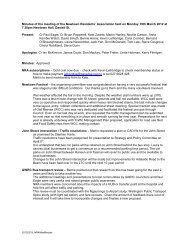Draft Town Belt Management Plan - Wellington City Council
Draft Town Belt Management Plan - Wellington City Council
Draft Town Belt Management Plan - Wellington City Council
Create successful ePaper yourself
Turn your PDF publications into a flip-book with our unique Google optimized e-Paper software.
public use of the area. This is also important to help reduce the <strong>Town</strong> <strong>Belt</strong> as a potential reservoir<br />
of weed infestation for other areas.<br />
One of the key contributors to weed establishment and spread in the <strong>Town</strong> <strong>Belt</strong> is the ongoing<br />
dumping of garden waste and movement of weed seeds from residential properties that back onto<br />
<strong>Town</strong> <strong>Belt</strong>.<br />
Due to the large number of pests, the greatest challenge for the <strong>Town</strong> <strong>Belt</strong> and citywide is to<br />
correctly prioritise control and use resources effectively.<br />
5.3.3 Carbon management<br />
As part of the <strong>Council</strong>'s climate change work programme the <strong>Council</strong>:<br />
• is placing eligible land into the Government's forest sink programmes so that it can<br />
generate emission unit returns on an annual basis<br />
• has requested an allocation of emission units for the <strong>Council</strong>'s older pine forest land (ie<br />
forest established before 1 Jan 1990).<br />
Some <strong>Town</strong> <strong>Belt</strong> areas have been included in the <strong>Council</strong>'s forest sink work programme. This<br />
includes:<br />
1. 1.2ha of post-1989 pine forest located on Berhampore Golf Course entered by the<br />
<strong>Council</strong> into the Emissions Trading Scheme (ETS). Owners of post-1989 forest land (as well<br />
as those with rights to post-1989 forests), who voluntarily enter the ETS, earn carbon<br />
credits called New Zealand Units (NZUs) as their forests grow. If and when the forest owner<br />
harvests their ETS forests, the owner must pay back the Government the NZUs that are<br />
equivalent to the amount of carbon lost through harvesting.<br />
2. 103.45 hectares of pre-1990 pine forests for which <strong>Council</strong> requested an allocation<br />
under the ETS. Pre-1990 forest landowners were eligible for a one-off allocation of NZUs<br />
from the Government.<br />
3 16ha of indigenous forest near Mt Albert that the <strong>Council</strong> is seeking to register in the<br />
Permanent Forest Sink Initiative (PFSI). The PFSI scheme promotes the establishment of<br />
permanent indigenous or exotic forests on previously unforested land with the aim of<br />
reducing climate-change effects.<br />
5.4 Objectives<br />
5.4.1 Ensure the protection of indigenous habitats on the <strong>Town</strong> <strong>Belt</strong> so that:<br />
• the biodiversity of the <strong>Town</strong> <strong>Belt</strong> is protected, enhanced and functions as a<br />
well-connected system<br />
• pest plants and animals are controlled efficiently and effectively.<br />
5.4.2 Restore and enhance streams and indigenous ecosystems on the <strong>Town</strong> <strong>Belt</strong> so<br />
that:<br />
• stormwater is managed and sedimentation minimised<br />
• communities are motivated, inspired and educated to get involved in<br />
restoration projects on the <strong>Town</strong> <strong>Belt</strong>.<br />
5.4.3 Gradually increase the indigenous vegetation cover on the <strong>Town</strong> <strong>Belt</strong> so that:<br />
• citywide ecological connectivity is improved and existing ecosystems<br />
enhanced<br />
• the ecological resilience of the city is improved.<br />
38<br />
<strong>Draft</strong> <strong>Town</strong> <strong>Belt</strong> <strong>Management</strong> <strong>Plan</strong> October 2012





